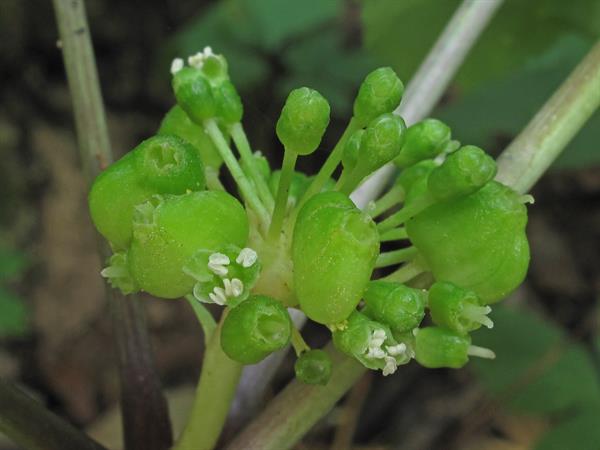
Origin/Endemic status: Native
Other Comments: P. quinquefolius is gathered in quantity throughout its range for the herbal trade; most of the North American harvest is shipped to China, where it is prized for medicinal uses. Dried roots command prices in excess of $1000 per kilogram; in our area, "sang" is a multimillion dollar industry. Formerly abundant and occurring in large populations, P. quinquefolius has been reduced in most of its range to small populations of scattered individuals, a classic example of a "predator-prey" relationship. Collection and trade in ginseng is monitored and regulated in most states. In NC, it is illegal for ginseng dealers to buy ginseng from collectors before Sep; this allows the plants to mature fruits prior to collection. Schlessman (1985) discusses the floral biology of P. quinquefolius.
Synonymy: = Ar, F, Il, K1, K3, K4, Mi, Mo2, Ok, Pa, Tn, Va, W, WV, Frodin & Govaerts (2003), Haines (2020a), Smith (1944); = Panax quinquefolium L. – C, G, GrPl, RAB, S, S13, Tat, orthographic variant
Heliophily: 2
Hover over a shape, letter, icon, or arrow on the map for definition or see the legend.
 © Alan M. Cressler | Original Image ⭷
© Alan M. Cressler | Original Image ⭷ © Keith Bradley | Original Image ⭷
© Keith Bradley | Original Image ⭷ © Keith Bradley | Original Image ⭷
© Keith Bradley | Original Image ⭷ © Gary P. Fleming | Original Image ⭷
© Gary P. Fleming | Original Image ⭷ © Alan Cressler: Panax quinquefolius, Chattahoochee River National Recreation Area, Fulton County, Georgia 2 by Alan Cressler source | Original Image ⭷
© Alan Cressler: Panax quinquefolius, Chattahoochee River National Recreation Area, Fulton County, Georgia 2 by Alan Cressler source | Original Image ⭷ © Erik Danielson source | Original Image ⭷
© Erik Danielson source | Original Image ⭷ © Alan M. Cressler | Original Image ⭷
© Alan M. Cressler | Original Image ⭷ © Erik Danielson source | Original Image ⭷
© Erik Danielson source | Original Image ⭷ © Bruce Sorrie | Original Image ⭷
© Bruce Sorrie | Original Image ⭷ © Erik Danielson source | Original Image ⭷
© Erik Danielson source | Original Image ⭷Feedback
See something wrong or missing on about Panax quinquefolius? Let us know here: (Please include your name and email if at all complicated so we can clarify if needed.)
Cite as...